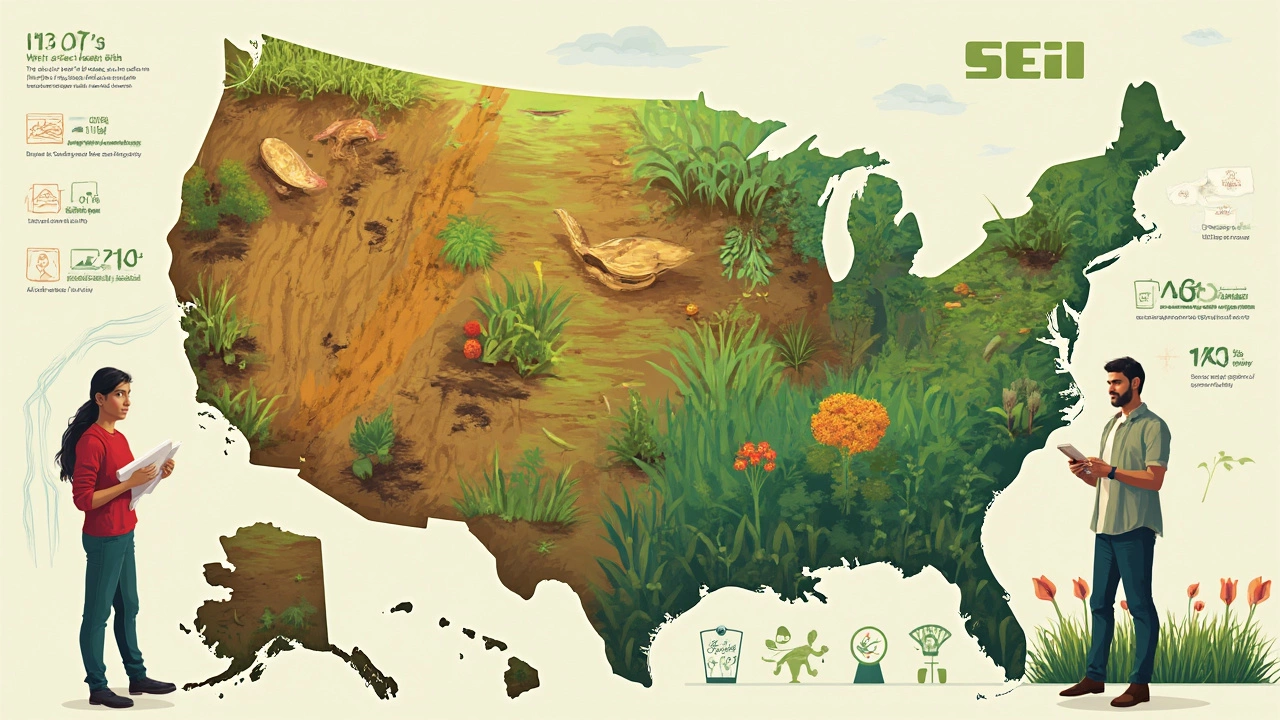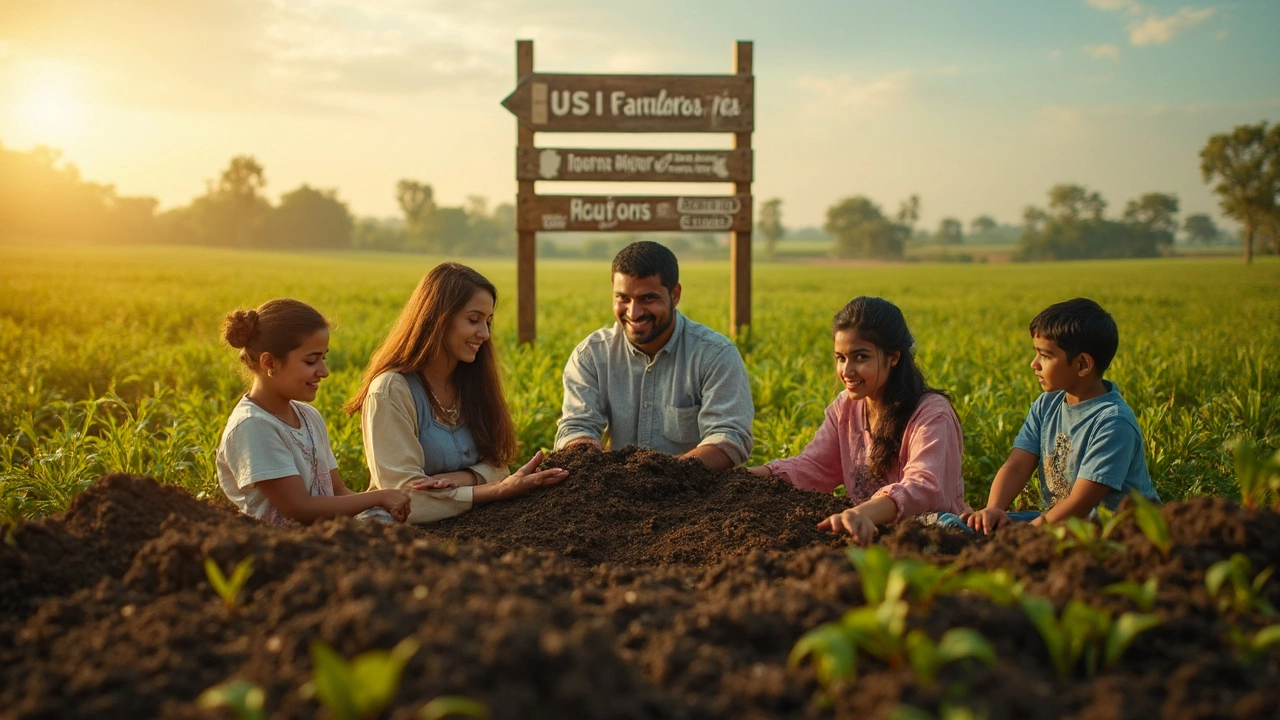So you’re thinking about buying land—maybe dreaming of your own farm, a lush garden, or just hoping for a future payoff. Here’s the thing: not all dirt is the same. Soil quality can make or break your plans, especially if you care about crops, trees, or even resale value.
Some states are famous for soil that’s almost too good: think deep, dark, crumbly stuff that smells earthy and grows corn so tall you get lost in it. Other places? Well, you might be stuck with clay that cracks like a desert, or sand that won’t hold a drop of water in July.
If you want land that pays off, knowing where to look for the best soil is half the battle. But what actually makes soil “the best”? Is it how easy it is to dig, or maybe how plants seem to thrive without a ton of fertilizers?
You don’t need a geology degree to get this right. A few simple soil tips can save you from a money pit—and help you spot land with real long-term potential. So, where should you be looking, and what should you check before you sign anything? Let’s answer those questions, starting with why soil should be at the top of your checklist.
- Why Soil Matters for Land Buyers
- Top States with the Richest Soil
- What Makes Soil 'Good' Anyway?
- Tips for Assessing Soil Before You Buy
Why Soil Matters for Land Buyers
If you’re buying land, soil isn’t just some technical detail—it’s the make-or-break factor for growing things, building, or investing. The right soil can save you thousands on farming, gardening, or prepping land for a house. On the flip side, bad soil means extra costs, headaches, or even total failure if you’re counting on crops or trees. This is where getting clued in on best soil US really pays off.
For anyone eyeing agriculture or even just a garden, soil decides what you can grow and how much. Black, rich dirt like the stuff in Iowa can feed cornfields for decades. Sandy soils like in Florida? Good luck growing wheat or holding water in a drought. That’s why serious farmers stick with proven states—they know the dirt pays off.
Building on land? You want soil that drains well, won’t shift, and supports stable foundations. Clay-heavy soils can swell and shrink, which can crack your driveway or basement. If you’re in it for investment, fertile land just holds value better—especially with the growing interest in hobby farming and organic food.
Check out this simple breakdown of how top soil types affect your plans:
| Soil Type | Common States | Best For | Pitfalls |
|---|---|---|---|
| Loam | Iowa, Illinois | Farming, gardening | High demand, can be pricey |
| Clay | Texas, Oklahoma | Ponds, bricks | Poor drainage, cracks |
| Sand | Florida, Nevada | Building, cactus gardens | Dries out fast |
| Silt | Mississippi, Arkansas | Rice, wet crops | Erosion risk |
If you’re buying, don’t just look at the listings. Ask about the soil, check the USDA maps, or bring a simple soil test kit. Even if you’re not planting a field, good dirt gives you options—and options put you ahead when it’s time to sell or develop the land.
- Farming or gardening? Go for loam in states like Iowa or Illinois.
- Building a home or barn? Check if the soil drains well and is stable in every season.
- Long-term value? Land with healthy, versatile soil almost always sells faster and at better prices.
Top States with the Richest Soil
When people ask about the best soil US states have to offer, there’s a reason the Midwest comes up a lot. Iowa, Illinois, and parts of Minnesota are famous for their deep, dark, loamy soil—called "mollisols" by soil scientists. This isn’t just hype. These soils are loaded with organic matter, hold water like a sponge, and need less fertilizer than most. In fact, some of the world’s best corn and soybeans come out of this region year after year.
So why does Midwest soil beat out most other places? It was shaped by glaciers thousands of years ago. As glaciers melted, they left layers of rich stuff behind. The prairies that grew on top kept adding dead plant material, making the ground even richer. Today, this land is gold for anyone wanting to farm or invest in land for crops.
Here’s a quick look at the states most known for fertile ground. Check out this table with some fast facts:
| State | Soil Type | Key Crops Grown | USDA Land Capability Class (1=best) |
|---|---|---|---|
| Iowa | Mollisols (loam) | Corn, Soybeans | 1-2 |
| Illinois | Mollisols (silt loam) | Corn, Soybeans, Wheat | 1 |
| Nebraska | Mollisols (loam/silt loam) | Corn, Wheat, Sorghum | 2 |
| Indiana | Mollisols, Alfisols | Corn, Soybeans | 1-2 |
| Minnesota | Mollisols (prairie soils) | Corn, Soybeans, Wheat | 1-2 |
Outside the Midwest, a few areas in California, especially the Central Valley, have alluvial soils that are great for fruits and veggies. But you’ll find more expensive land and water shortages there. In the South, states like Alabama and Mississippi have "prime farmland" spots, but it’s not as widespread as in the Corn Belt.
Here’s a tip: USDA puts out maps showing land capability—classes 1 and 2 are the most desirable for agriculture because they need fewer fixes. If you’re buying with farming in mind, those are your sweet spots. Just remember, even within a "great" state, soil can change a lot by county and even by field, so check the local soil survey before you buy.

What Makes Soil 'Good' Anyway?
It’s easy to think all dirt is the same, but there’s real science behind why some soil is way better for growing things. Let’s break it down with basics that matter to anyone eyeing land for sale or farming.
Good soil keeps plants happy for one reason: it holds the right amount of water and nutrients while letting roots breathe. If the ground doesn’t drain well, roots rot. If it’s too sandy, water runs off and plants dry out. So, a “happy medium” matters.
- Texture: The ideal soil, called loam, mixes sand, silt, and clay almost perfectly. Loam is crumbly and dark, not sticky or powdery. That’s what you want if yield and ease are your goals.
- pH Level: Most crops like soil that sits near neutral on the pH scale (about 6.0–7.0). Acidic or alkaline soil will stunt plants, make nutrients less available, or cause certain minerals to build up.
- Nutrient Content: Plants need a mix of nitrogen, phosphorus, and potassium, plus smaller bits like calcium and magnesium. These nutrients are boosted by organic matter—think dead leaves or manure breaking down.
- Organic Matter: If the soil looks dark and smells earthy, that’s a good sign. High organic content means great structure and more nutrients for anything you plant.
- Drainage: Water needs to hang around long enough for plants, but not drown them. Do a simple test: dig a hole, dump in a bucket of water, and check how fast it drains. Too slow or too quick, and you’ve got fixes to make.
How do different states in the US rank for these factors? Here’s a quick look at soil characteristics in a few well-known farming states:
| State | Soil Type | Organic Matter (%) | Average pH | General Texture |
|---|---|---|---|---|
| Iowa | Mollisols (Black Dirt) | 5-8 | 6.5-7.2 | Loam |
| Illinois | Mollisols | 4-7 | 6.2-7.1 | Loam/Silty Loam |
| Nebraska | Mollisols & Alfisols | 3-6 | 6.0-7.0 | Silt Loam |
| California (Central Valley) | Entisols/Inceptisols | 1-3 | 6.1-7.5 | Sandy Loam |
| Florida | Spodosols/Ultisols | 1-2 | 5.5-6.5 | Sandy |
If you care about best soil US for crops, nutrients, and future yield, these facts make Iowa and Illinois look pretty solid at the top. Their black dirt, officially called Mollisols, holds more nutrients and moisture than soil in drier or sandier places like Florida.
One last tip—soil can be improved, but great native soil is hard to beat for less effort and long-term gains. Always pay attention to what’s under your feet before you commit to that perfect piece of land.
Tips for Assessing Soil Before You Buy
Picking land just because it “looks green” is risky business. There’s no shortcut here: getting a sense of the ground you’re buying takes more than a quick glance. Here’s what matters most if you want the best soil US options for farming or investment to actually work out.
First up, get a soil test—before you buy. Most counties have local extension offices that’ll run a basic test for under $50. What you get: a breakdown of pH, nutrients (like nitrogen and potassium), and sometimes even organic matter. These are the numbers farmers actually pay attention to because poor results can mean hundreds more in fertilizer down the road.
Dig a hole and really look at the soil. Go at least a foot deep, if you can. Good soil has a rich, dark look and feels crumbly, not sticky or super dry. If you see a thick layer of gray, white, or orange clay right under the grass: big warning sign. That’s tough for roots, and water will pool or run off instead of soaking in. Sandy soils drain fast but dry out quickly, which could be annoying for gardens—unless you want cacti, of course.
- Try the "ribbon test": roll moist soil between your fingers. If it forms a ribbon and holds together, chances are you’ve got clay. Sandy soil won’t hold well—it’ll crumble fast. Loam (the gold standard) makes a short, stable ribbon: that’s what you want for most crops.
- Check for worms and bugs. Lots of critters mean healthy, living soil. Empty, hard-packed dirt? Skip it unless you’re ready for serious rehab.
- Take a walk during or right after rain. If you find puddles hanging around for days, drainage might be trouble. That can wreck foundations, rot roots, and send you running to fix it after every storm.
Ask neighbors about what grows well and what headaches come up. Local farmers are a gold mine for honest answers. They’ll tell you straight if everything’s been stunted by salt, or if you’re looking at land that’s needed endless chemicals to stay productive.
“Don’t just buy with your eyes—soil can hide problems you won’t see until you plant your first crop,” says Dr. Ronald Phillips, a longtime soil scientist at the University of Minnesota.
Last but not least, check for old use—was this land a cornfield, pasture, or a dump? Old industrial use can mean contamination. Sometimes, old farmers leave behind tanks and trash that leak into the ground. A search with your county’s records or a quick chat with an experienced local can save you a serious headache.
If you want healthy plants, stable buildings, and good resale value, ignore soil at your own risk. Spend a little time up front to check it out, and you’ll thank yourself every season you don’t have to fight with the dirt.
